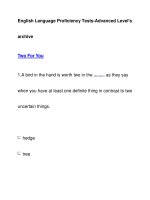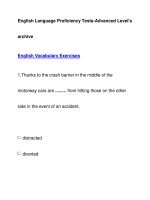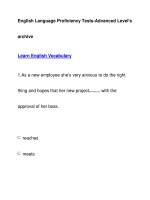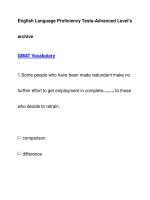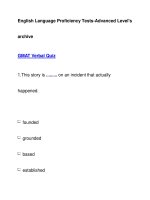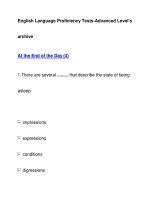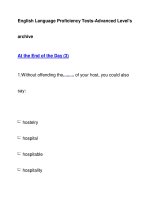ENGLISH PROFICIENCY TEST
Bạn đang xem bản rút gọn của tài liệu. Xem và tải ngay bản đầy đủ của tài liệu tại đây (175.57 KB, 11 trang )
ENGLISH PROFICIENCY TEST
Subject: READING
Date:
Full name: ……………………………
Place: DA NANG
Time: 60 minutes
Reg. No: ………………...
DCFL
INTRUCTIONS
In this section you will read four passages. Each one is followed by 10 questions
about it. For questions 1-40, you are to choose the best answer A, B, C or D, to each
question. Then, on your answer sheet, find the number of the question and fill in the
space that corresponds to the letter of the answer you have chosen. Answer all the
questions following a passage on the basic of what is stated or implied in that
passage.
Example
Read the following passage:
FALL WEATHER
One of the best things we look for in fall is the first floor and freeze of the season,
killing or sending into dormancy the beautiful vegetation you admired all summer
long. For some locations along the Canadian border, and in the higher terrain of the
West, the first freeze typically arrives by the middle part of November, though a frost
is very possible before then. A few cities in the Lower 48, including International
Falls, Minnesota and Grand Forks, North Dakota, have recorded a freeze in every
month of the year.
0. When does the first freeze often arrive in the South?
A. Early September
B. Mid September
C. November
D. Before November
You will read in the passage that “Cities in the South may not see the first freeze until
November”, so the correct answer is option C. November.
Passage 1 - Question 1-8
1
With Robert Laurent and William Zorach, direct carving enters into the story
of modern sculpture in the United States. Direct carving – in which the
sculptors themselves carve stone or wood with mallet and chisel – must be
recognized as something more than just a technique. Implicit in it is an
DCFL 1
aesthetic principle as well: that the medium has certain qualities of beauty and
expressiveness with which sculptors must bring their own aesthetic sensibilities
into harmony. For example, sometimes the shape or veining in a piece of stone
or wood suggests, perhaps even dictates, not only the ultimate form, but even
the subject matter.
2
The technique of direct carving was a break with the nineteenth-century
tradition in which the making of a clay model was considered the creative act
and the work was then turned over to studio assistants to be cast in plaster or
bronze or carved in marble.
3
Neoclassical sculptors seldom held a mallet or chisel in their own hands,
readily conceding that the assistants they employed were far better than they
were at carving the finished marble.
4
With the turn-of-the-century Crafts movement and the discovery of
nontraditional sources of inspiration, such as wooden African figures and
masks, there arose a new urge for hands-on, personal execution of art and an
interaction with the medium. Even as early as the 1880’s and 1890’s,
nonconformist European artists were attempting direct carving. By the second
decade of the twentieth century, Americans- Laurent and Zorach most notably –
had adopted it as their primary means of working.
5
Born in France, Robert Laurent (1890-1970) was a prodigy who received his
education in the United States. In 1905 he was sent to Paris as an apprentice to
an art dealer, and in the years that followed he witnessed the birth of Cubism,
discovered primitive art, and learned the techniques of woodcarving from a
frame maker.
6
Back in New York City by 1910, Laurent began carving pieces such as The
Priestess, which reveals his fascination with African, pre-Columbian, and
South Pacific art. Taking a walnut plank, the sculptor carved the expressive,
stylized design. It is one of the earliest examples of direct carving in American
sculpture. The plank’s form dictated the rigidly frontal view and the low relief.
Even its irregular shape must have appealed to Laurent as a break with a longstanding tradition that required a sculptor to work within a perfect rectangle or
square.
1. The word “medium” in passage 1 could be used to refer to
A. stone or wood
B. mallet and chisel
C. technique
DCFL 2
D. principle
2. What is one of the fundamental principles of direct carving?
A. A sculptor must work with talented assistants
B. The subject of a sculpture should be derived from classical stories
C. The material is an important element in a sculpture
D. Designing a sculpture is a more creative activity than carving it
3. The word “dictates” in passage 1 is closest in meaning to
A. reads aloud
B. determines
C. includes
D. records
4. How does direct carving differ from the nineteenth-century tradition of
sculpture?
A. Sculptors are personally involved in the carving of a piece.
B. Sculptors find their inspiration in neoclassical sources.
C. Sculptors have replaced the mallet and chisel with other tools.
D. Sculptors receive more formal training.
5. The word “witnessed” in passage 5 is closest in meaning to
A. influenced
B. studied
C. validated
D. observed
6. Where did Robert Laurent learn to carve?
A. New York
B. Africa
C. The South Pacific
D. Paris
7. The phrase “a break with” in passage 6 is closest in meaning to
A. a destruction of
B. a departure from
C. a collapse of
D. a solution to
8. The piece titled The Priestess has all of the following characteristics EXCEPT
A. The design is stylized.
B. It is made of marble.
C. The carving is not deep.
D. It depicts the front of a person.
DCFL 3
Passage 2 - Questions 9-19
1
Birds that feed in flocks commonly retire together into roosts. The reasons
for roosting communally are not always obvious, but there are some likely
benefits. In winter especially, it is important for birds to keep warm at night and
conserve precious food reserves. One way to do this is to find a sheltered roost.
Solitary roosters shelter in dense vegetation or enter a cavity – horned larks dig
holes in the ground and ptarmigan burrow into snow banks – but the effect of
sheltering is magnified by several birds huddling together in the roosts, as
wrens, swifts, brown creepers, bluebirds, and anis do. Body contact reduces the
surface area exposed to the cold air, so the birds keep each other warm. Two
kinglets huddling together were found to reduce their heat losses by a quarter
and three together saved a third of their heat.
2
The second possible benefit of communal roosts is that they act as
“information centers.” During the day, parties of birds will have spread out to
forage over a large area. When they return in the evening some will have fed
well, but others may have found little to eat. Some investigators have observed
that when the birds set out again next morning, those birds that did not feed
well on the previous day appear to follow those that did. The behavior of
common and lesser kestrels may illustrate different feeding behaviors of similar
birds with different roosting habits. The common kestrel hunts vertebrate
animals in a small, familiar hunting ground, whereas the very similar lesser
kestrel feeds on insects over a large area. The common kestrel roosts and hunts
alone, but the lesser kestrel roosts and hunts in flocks, possibly so one bird can
learn from others where to find insect swarms.
3
Finally, there is safety in numbers at communal roosts since there will
always be a few birds awake at any given moment to give the alarm. But this
increased protection is partially counteracted by the fact that mass roosts
attract predators and are especially vulnerable if they are on the ground. Even
those in trees can be attacked by birds of prey. The birds on the edge are at
greatest risk since predators find it easier to catch small birds perching at the
margins of the roost.
9. What does the passage mainly discuss?
A. How birds find and store food
B. How birds maintain body heat in the winter
C. Why birds need to establish territory
D. Why some species of birds nest together
10. The word “conserve” in passage 1 is closest in meaning to
A. retain
DCFL 4
B. watch
C. locate
D. share
11. Ptarmigan keep warm in the winter by
A. huddling together on the ground with other birds
B. building nests in trees
C. burrowing into dense patches of vegetation
D. digging tunnels into the snow
12. The word “magnified” in passage 1 is closest in meaning to
A. caused
B. modified
C. intensified
D. combined
13. The author mentions kinglets in passage 1 as an example of birds that
A. protect themselves by nesting in holes
B. nest with other species of birds
C. nest together for warmth
D. usually feed and nest in pairs
14. The word “forage” in passage 2 is closest in meaning to
A. fly
B. assemble
C. feed
D. rest
15. Which of the following statements about lesser and common kestrels is true?
A. The lesser kestrel and the common kestrel have similar diets.
B. The lesser kestrel feeds sociably but the common kestrel does not.
C. The common kestrel nests in larger flocks than does the lesser kestrel.
D. The common kestrel nests in trees; the lesser kestrel nests on the ground.
16. The word “counteracted” in passage 3 is closest in meaning to
A. suggested
B. negated
C. measured
D. shielded
17. Which of the following is NOT mentioned in the passage as an advantage
derived by birds that huddle together while sleeping?
A. Some members of the flock warn others of impending dangers.
B. Staying together provides a greater amount of heat for the whole flock.
C. Some birds in the flock function as information centers for others who are
looking for food.
DCFL 5
D. Several members of the flock care for the young.
18. Which of the following is a disadvantage of communal roosts that is
mentioned in the passage?
A. Diseases easily spread among the birds.
B. Groups are more attractive to predators than individual birds.
C. Food supplies are quickly depleted.
D. Some birds in the group will attack the others.
19. The word “they” in passage 3 refers to
A. a few birds
B. mass roosts
C. predators
D. trees
Passage 3 - Questions 20-30
1
Before the mid-nineteenth century, people in the United States ate most
foods only in season. Drying, smoking, and salting could preserve meat for a
short time, but the availability of fresh meat, like that of fresh milk, was very
limited; there was no way to prevent spoilage. But in 1810 a French inventor
named Nicolas Appert developed the cooking-and-sealing process of canning.
And in the 1850’s an American named Gail Borden developed a means of
condensing and preserving milk. Canned goods and condensed milk came more
common during the 1860’s, but supplies remained low because cans had to be
made by hand. By 1880, however, inventors had fashioned stamping and
soldering machines that mass-produced cans from tinplate. Suddenly all kinds
of food could be preserved and bought at all times of the year.
2
Other trends and inventions had also helped make it possible for Americans
to vary their daily diets. Growing urban populations created demand that
encouraged fruit and vegetable farmers to raise more produce. Railroad
refrigerator cars enabled growers and meats packers to ship perishables great
distances and to preserve them for longer periods. Thus, by the 1890's, northern
city dwellers could enjoy southern and western strawberries, grapes, and
tomatoes, previously available for a month at most, for up to six months of the
year. In addition, increased use of iceboxes enabled families to store
perishables. An easy means of producing ice commercially had been invented
in the 1870's, and by 1900 the nation had more than two thousand commercial
ice plants, most of which made home deliveries. The icebox became a fixture
DCFL 6
in most homes and remained so until the mechanized refrigerator replaced it in
the 1920's and 1930's.
3
Almost everyone now had a more diversified diet. Some people continued to
eat mainly foods that were heavy in starches or carbohydrates, and not
everyone could afford meat. Nevertheless, many families could take advantage
of previously unavailable fruits, vegetables, and dairy products to achieve more
varied fare.
20. What does the passage mainly discuss?
A. Causes of food spoilage
B. Commercial production of ice
C. Inventions that led to changes in the American diet
D. Population movements in the nineteenth century
21. The phrase “in season” in passage 1 refers to
A. a kind of weather
B. a particular time of year
C. an official schedule
D. a method of flavoring food
22. The word “prevent” in passage 1 is closest in meaning to
A. estimate
B. avoid
C. correct
D. confine
23. During the 1860’s, canned food products were
A. unavailable in rural areas
B. shipped in refrigerator cars
C. available in limited quantities
D. a staple part of the American diet
24. It can be inferred that railroad refrigerator cars came into use
A. before 1860
B. before 1890
C. after 1900
D. after 1920
25. The word “them” in passage 2 refers to
A. refrigerator cars
B. perishables
C. growers
D. distances
26. The word “fixture” in passage 2 is closest in meaning to
DCFL 7
A. luxury item
B. substance
C. commonplace object
D. mechanical device
27. The author implies that in the 1920’s and 1930’s home deliveries of ice
A. decreased in number
B. were on an irregular schedule
C. increased in cost
D. occurred only in the summer
28. The word “Nevertheless” in passage 3 is closest in meaning to
A. therefore
B. because
C. occasionally
D. however
29. Which of the following types of food preservations was NOT mentioned in the
passage?
A. Drying
B. Canning
C. Cold storage
D. Chemical additives
30. Which of the following statements is supported by the passage?
A. Tin cans and iceboxes helped to make many foods more widely available.
B. Commercial ice factories were developed by railroad owners.
C. Most farmers in the United States raised only fruits and vegetables.
D. People who lived in cities demanded home delivery of foods.
Passage 4 - Questions 31-40
1
The changing profile of a city in the United States is apparent in the shifting
definitions used by the United States Bureau of the Census. In 1870 the census
officially distinguished the nation's “urban” from its “rural” population for the
first Line time. “Urban population” was defined as persons living in towns of
8,000 inhabitants or more. But after 1900 it meant persons living in
incorporated places having 2,500 or more inhabitants. Then, in 1950 the
Census Bureau radically changed its definition of “urban” to take account of
the new vagueness of city boundaries. In addition to persons living in
incorporated units of 2,500 or more, the census now included those who lived
DCFL 8
in unincorporated units of that size, and also all persons living in the densely
settled urban fringe, including both incorporated and unincorporated areas
located around cities of 50,000 inhabitants or more. Each such unit, conceived
as an integrated economic and social unit with a large population nucleus, was
named a Standard Metropolitan Statistical Area (SMSA).
2
Each SMSA would contain at least (a) one central city with 50,000
inhabitants or more or (b) two cities having shared boundaries and constituting,
for general economic and social purposes, a single community with a combined
population of at least 50,000, the smaller of which must have a population of at
least 15,000. Such an area included the county in which the central city is
located, and adjacent counties that are found to be metropolitan in character
and economically and socially integrated with the county of the central city. By
1970, about two-thirds of the population of the United States was living in
these urbanized areas, and of that figure more than half were living outside the
central cities.
3
While the Census Bureau and the United States government used the term
SMSA (25) (by 1969 there were 233 of them), social scientists were also using
new terms to describe the elusive, vaguely defined areas reaching out from
what used to be simple “towns” and “cities”. A host of terms came into use :
“metropolitan regions,” “polynucleated population groups,” “conurbations,”
“metropolitan clusters,” “megalopolises,” and so on.
31. What does the passage mainly discuss?
A. How cities in the United States began and developed
B. Solutions to overcrowding in cities
C. The changing definition of an urban area
D. How the United States Census Bureau conducts a census
32. According to the passage, the population of the United States was first
classified as rural or urban in
A. 1870
B. 1900
C. 1950
D. 1970
33. The word “distinguished” in passage 1 is closest in meaning to
A. differentiated
B. removed
C. honored
D. protected
34. Prior to 1900, how many inhabitants would a town have to have before being
defined as urban?
A. 2,500
DCFL 9
B. 8,000
C. 15,000
D. 50,000
35. According to the passage, why did the Census Bureau revise the definition of
urban in 1950?
A. City borders had become less distinct.
B. Cities had undergone radical social change.
C. Elected officials could not agree on an acceptable definition.
D. New businesses had relocated to larger cities.
36. The word “those” in passage 1 refers to
A. boundaries
B. persons
C. units
D. areas
37. The word “constituting” in passage 2 is closest in meaning to
A. located near
B. determined by
C. calling for
D. making up
38. The word “which” in passage 2 refers to a smaller
A. population
B. city
C. character
D. figure
39. Which of the following is NOT true of an SMSA?
A. It has a population of at least 50,000
B. It can include a city’s outlying regions.
C. It can include unincorporated regions.
D. It consists of at least two cities.
40. By 1970, what proportion of the population in the United States did NOT live
in an SMSA?
A. 3/4
B. 2/3
C. 1/2
D. 1/3
DCFL 10
.
DCFL 11


